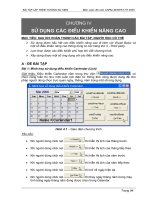Chuong 4 rip, ospf
Bạn đang xem bản rút gọn của tài liệu. Xem và tải ngay bản đầy đủ của tài liệu tại đây (4.28 MB, 78 trang )
Chapter 14
Unicast Routing Protocols:
RIP, OSPF, and BGP
Objectives
Upon completion you will be able to:
• Distinguish between intra and interdomain routing
• Understand distance vector routing and RIP
• Understand link state routing and OSPF
• Understand path vector routing and BGP
TCP/IP Protocol Suite
1
14.1 INTRA- AND INTERDOMAIN
ROUTING
Routing inside an autonomous system is referred to as intradomain
routing. Routing between autonomous systems is referred to as
interdomain routing.
TCP/IP Protocol Suite
2
Figure 14.1 Autonomous systems
TCP/IP Protocol Suite
3
Figure 14.2 Popular routing protocols
TCP/IP Protocol Suite
4
14.2 DISTANCE VECTOR ROUTING
In distance vector routing, the least cost route between any two nodes is
the route with minimum distance. In this protocol each node maintains a
vector (table) of minimum distances to every node
The topics discussed in this section include:
Initialization
Sharing
Updating
When to Share
Two-Node Loop Instability
Three-Node Instability
TCP/IP Protocol Suite
5
Figure 14.3 Distance vector routing tables
TCP/IP Protocol Suite
6
Figure 14.4 Initialization of tables in distance vector routing
TCP/IP Protocol Suite
7
Note:
In distance vector routing, each node
shares its routing table with its
immediate neighbors periodically and
when there is a change.
TCP/IP Protocol Suite
8
Figure 14.5 Updating in distance vector routing
TCP/IP Protocol Suite
9
Figure 14.6 Two-node instability
TCP/IP Protocol Suite
10
Figure 14.7 Three-node instability
TCP/IP Protocol Suite
11
14.3 RIP
The Routing Information Protocol (RIP) is an intradomain routing
protocol used inside an autonomous system. It is a very simple protocol
based on distance vector routing.
The topics discussed in this section include:
RIP Message Format
Requests and Responses
Timers in RIP
RIP Version 2
Encapsulation
TCP/IP Protocol Suite
12
Figure 14.8 Example of a domain using RIP
TCP/IP Protocol Suite
13
Figure 14.9 RIP message format
TCP/IP Protocol Suite
14
Figure 14.10 Request messages
TCP/IP Protocol Suite
15
Example 1
Figure 14.11 shows the update message sent from router R1 to
router R2 in Figure 14.8. The message is sent out of interface
130.10.0.2.
The message is prepared with the combination of split horizon
and poison reverse strategy in mind. Router R1 has obtained
information about networks 195.2.4.0, 195.2.5.0, and 195.2.6.0
from router R2. When R1 sends an update message to R2, it
replaces the actual value of the hop counts for these three
networks with 16 (infinity) to prevent any confusion for R2.
The figure also shows the table extracted from the message.
Router R2 uses the source address of the IP datagram carrying
the RIP message from R1 (130.10.02) as the next hop address.
TCP/IP Protocol Suite
See Next Slide
16
Figure 14.11 Solution to Example 1
TCP/IP Protocol Suite
17
Figure 14.12 RIP timers
TCP/IP Protocol Suite
18
Example 2
A routing table has 20 entries. It does not receive information
about five routes for 200 s. How many timers are running at
this time?
Solution
The 21 timers are listed below:
Periodic timer: 1
Expiration timer: 20 − 5 = 15
Garbage collection timer: 5
TCP/IP Protocol Suite
19
Figure 14.13 RIP version 2 format
TCP/IP Protocol Suite
20
Figure 14.14 Authentication
TCP/IP Protocol Suite
21
Note:
RIP uses the services of UDP on
well-known port 520.
TCP/IP Protocol Suite
22
14.4 LINK STATE ROUTING
In link state routing, if each node in the domain has the entire topology
of the domain, the node can use Dijkstra’s algorithm to build a routing
table.
The topics discussed in this section include:
Building Routing Tables
TCP/IP Protocol Suite
23
Figure 14.15 Concept of link state routing
TCP/IP Protocol Suite
24
Figure 14.16 Link state knowledge
TCP/IP Protocol Suite
25









